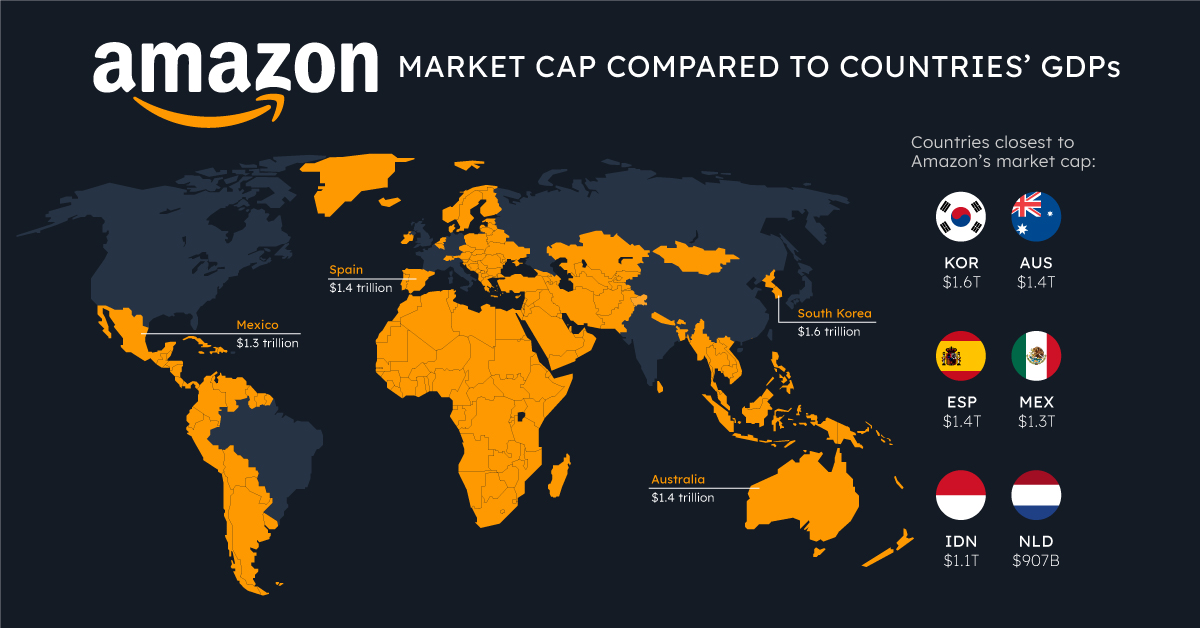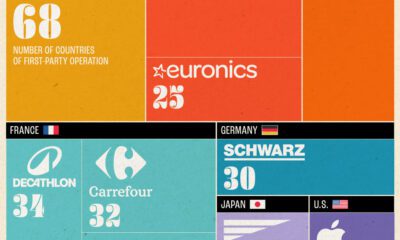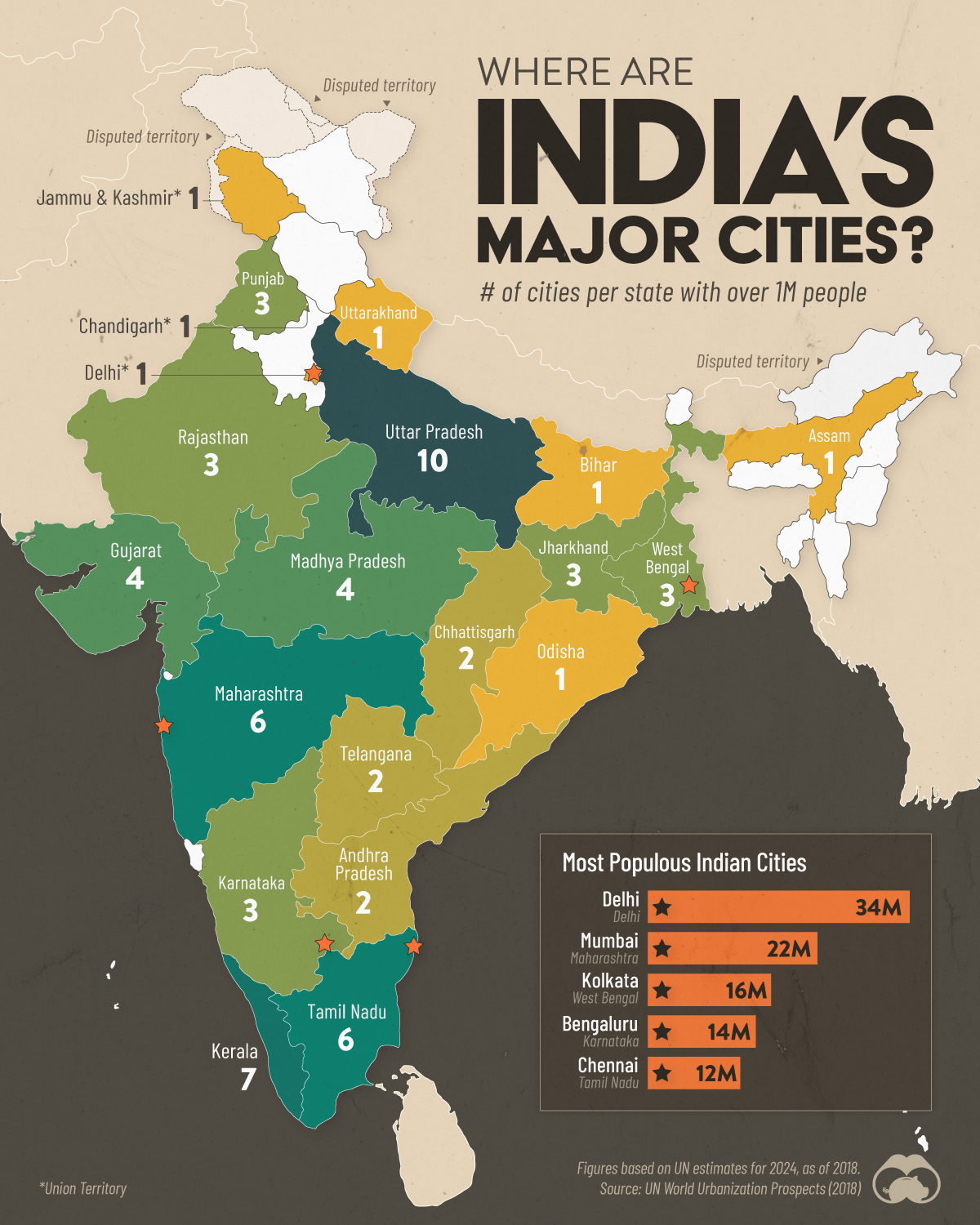Economy
The World’s Tech Giants, Compared to the Size of Economies
It’s no secret that tech giants have exploded in value over the last few years, but the scale can be hard to comprehend.
Through wide-scaling market penetration, smart diversification, and the transformation of products into services, Apple, Microsoft, Amazon, and Google have reached market capitalizations well above $1.5 trillion.
To help us better understand these staggering numbers, a recent study at Mackeeper took the market capitalization of multiple tech giants and compared them with the annual Gross Domestic Product (GDP) of countries.
Editor’s note: While these numbers are interesting to compare, it’s worth noting that they represent different things. Market cap is the total value of shares outstanding in a publicly-traded company and gives an indication of total valuation, and GDP measures the value of all goods and services produced by a country in an entire year.
Companies vs. Countries: Tech Giants
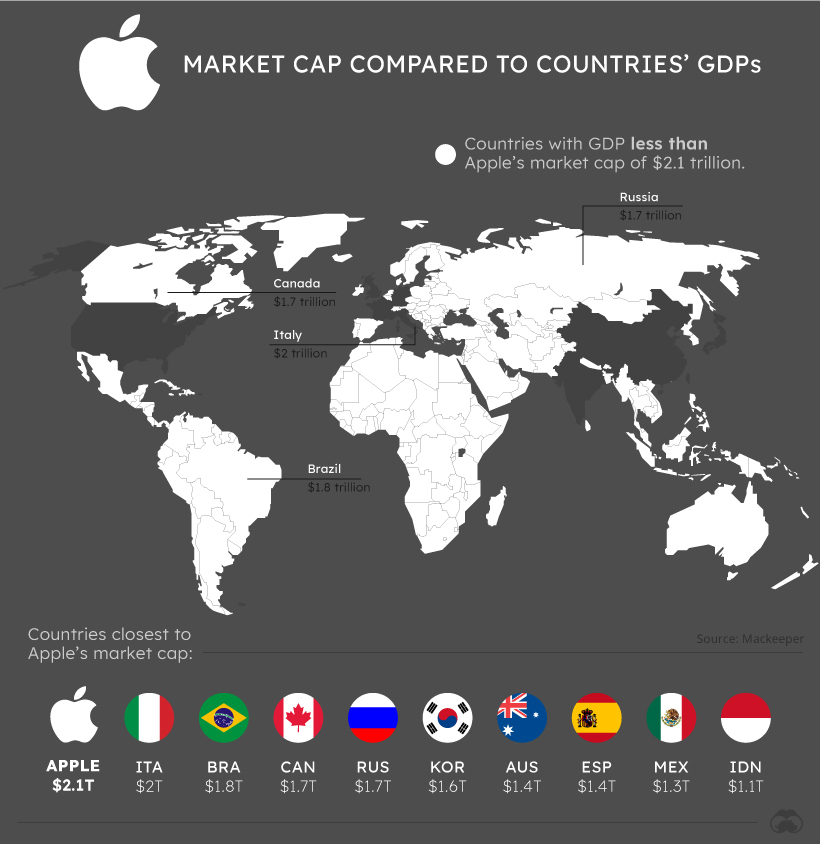
If Apple’s market capitalization was equal to a country’s annual GDP, it might just be in the G7.
At a market cap of more than $2.1 trillion, Apple’s market capitalization is larger than 96% of country GDPs, a list that includes Italy, Brazil, Canada, and Russia.
In fact, only seven countries in the world have a higher GDP than Apple’s market cap.
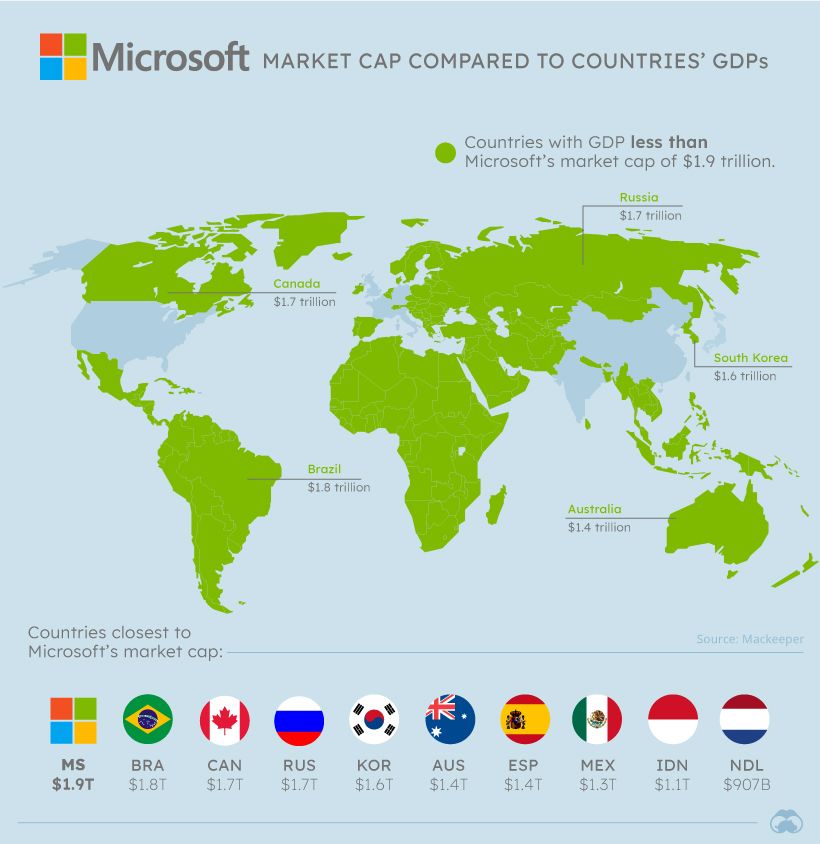
Further back is Microsoft, which would be the 10th richest country in the world if market cap was equivalent to GDP.
With a market cap of more than $1.9 trillion, Microsoft’s value is larger than the GDP of global powerhouses Brazil, Canada, Russia, and South Korea.
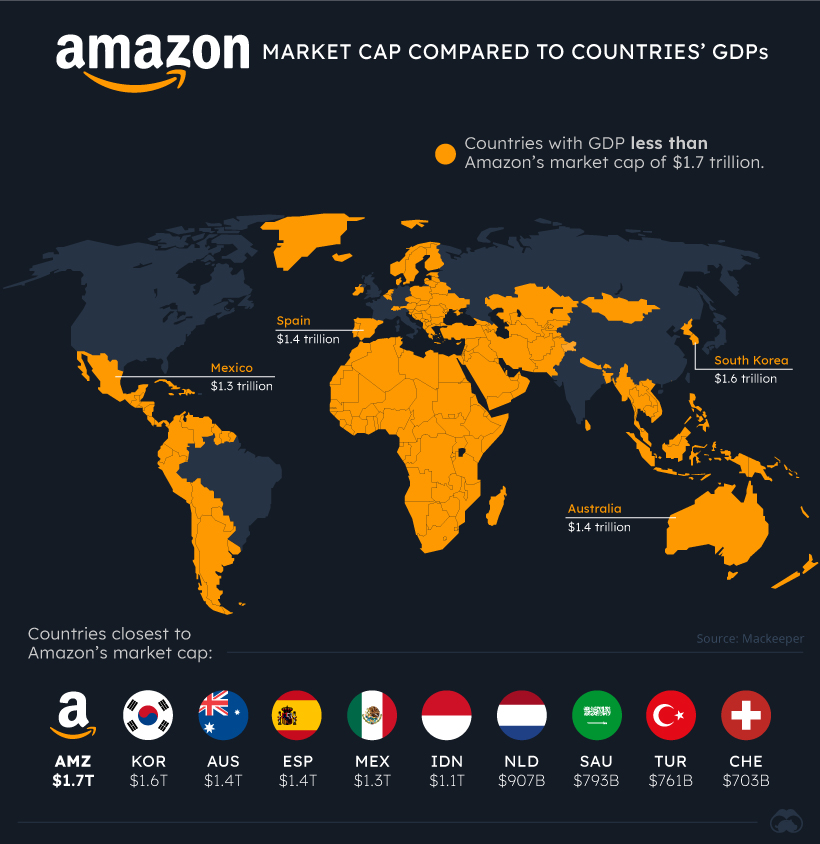
Though all of the tech giants fared well during the COVID-19 pandemic, perhaps none have stood to benefit as much as Amazon.
With online retail and web services both in high demand, Amazon’s market cap has grown to $1.7 trillion, larger than 92% of country GDPs.
Other Companies “Bigger” Than Countries
Tech giants aren’t the only companies that would give countries a run for their money.
| Country/Company | Nominal GDP (country) or Market Cap (company) |
|---|---|
| United States of America | $21,433 B |
| China | $14,343 B |
| Japan | $5,082 B |
| Germany | $3,861 B |
| India | $2,869 B |
| United Kingdom | $2,829 B |
| France | $2,716 B |
| Apple | $2,125 B |
| Italy | $2,004 B |
| Microsoft | $1,942 B |
| Saudi Aramco | $1,888 B |
| Brazil | $1,840 B |
| Canada | $1,736 B |
| Russia | $1700 B |
| Amazon | $1,688 B |
| Alphabet | $1,656 B |
| South Korea | $1,647 B |
| Australia | $1,397 B |
| Spain | $1,393 B |
| Mexico | $1,269 B |
| Indonesia | $1,119 B |
| $939 B | |
| Netherlands | $907 B |
| Saudi Arabia | $793 B |
| Turkey | $761 B |
| Tencent | $736 B |
| Switzerland | $703 B |
| Poland | $596 B |
Saudi Arabia’s state-owned corporation Saudi Aramco also makes the list, boasting a market cap more than double the GDP of its home country.
China’s tech giant Tencent also has a market cap that towers over many country GDPs, such as those of Switzerland or Poland.
Until recently, Tencent was also ahead of fellow tech giant Facebook in market cap, but the social network has climbed ahead and almost reached $1 trillion in market capitalization.
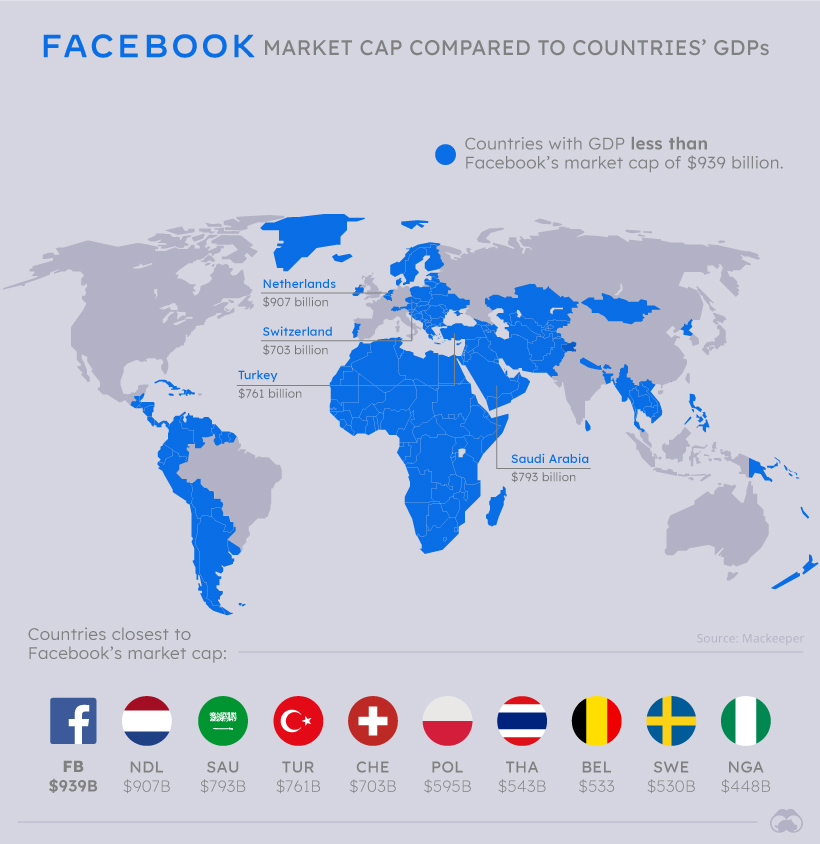
Of course, the biggest caveat to consider with these comparisons is the difference between market cap and GDP numbers.
A company’s market cap is a proxy of its net worth in the eyes of public markets and changes constantly, while GDP measures the economic output of a country in a given year.
But companies directly and indirectly affect the economies of countries around the world. With international reach, wealth accumulation, and impact, it’s important to consider just how much wealth and power these companies have.
Maps
Mapped: Indian States with Cities Over 1 Million People
Ten Indian states—most of them from the northeast region of the country—don’t have a single city with 1 million residents.
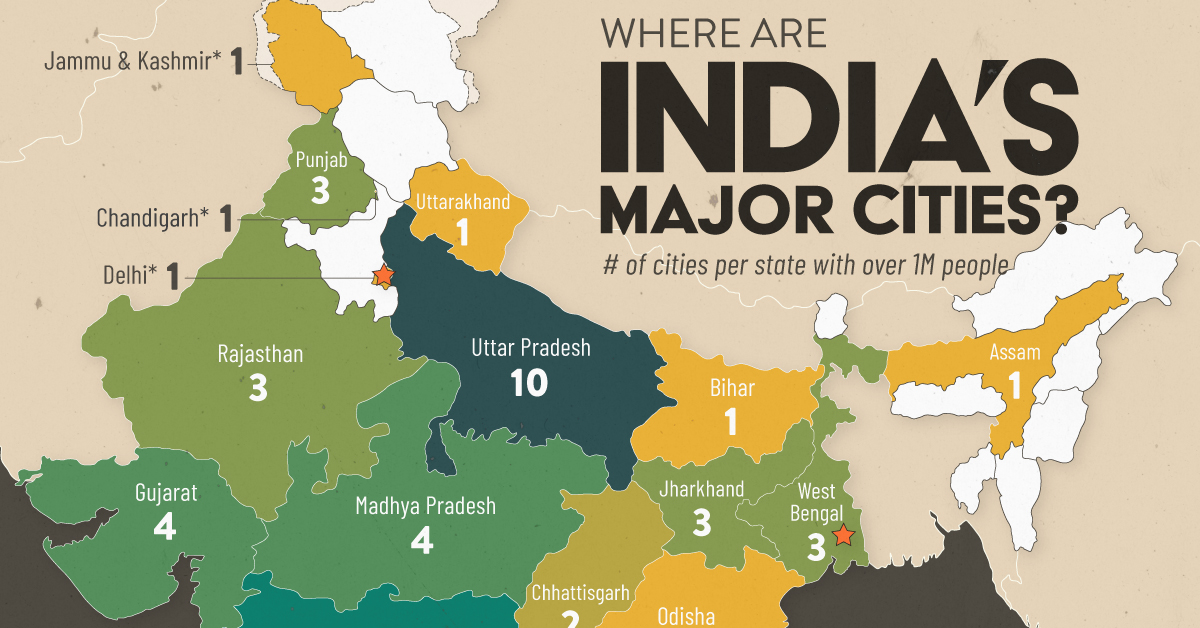
Mapped: Indian States with Cities Over 1 Million People
This was originally posted on our Voronoi app. Download the app for free on iOS or Android and discover incredible data-driven charts from a variety of trusted sources.
Slightly more than one-third of the 1.4 billion Indian population lives in an urban area. So where are the country’s most populous cities, and how are they spread across the country’s 28 states and eight union territories?
This map shows the number of Indian urban agglomerations (cities) with more than a million residents in each jurisdiction. Data for this graphic is sourced from 2024 urban agglomeration estimates in the UN World Urbanization Prospects.
Ranked: Indian States by Cities with 1M Residents
India’s Uttar Pradesh state has 10 cities with a population size of 1 million or more. It is also India’s most populous state, home to 240 million people. This makes it comparable to the size of Pakistan, the fifth most populous country in the world.
| Indian State | Cities with 1M Residents (2024) | City Names |
|---|---|---|
| Uttar Pradesh | 10 | Lucknow, Kanpur, Agra, Meerut, Varanasi, Prayagraj, Bareilly, Aligarh, Moradabad, Saharanpur |
| Kerala | 7 | Kozhikode, Malappuram, Thrissur, Kochi, Thiruvananthapura, Kannur, Kollam |
| Maharashtra | 6 | Mumbai, Pune, Nagpur, Nashik, Aurangabad, Solapur |
| Tamil Nadu | 6 | Chennai, Coimbatore, Madurai, Tiruppur, Tiruchirappalli, Salem |
| Gujarat | 4 | Ahmedabad, Surat, Vadodara, Rajkot |
| Madhya Pradesh | 4 | Indore, Bhopal, Jabalpur, Gwalior |
| Jharkhand | 3 | Jamshedpur, Ranchi, Dhanbad |
| Karnataka | 3 | Bengaluru, Mysore, Hubli-Dharwad |
| Punjab | 3 | Ludhiana, Amritsar, Jalandhar |
| Rajasthan | 3 | Jaipur, Jodhpur, Kota |
| West Bengal | 3 | Kolkata, Asansol, Siliguri |
| Andhra Pradesh | 2 | Visakhapatnam, Vijayawada |
| Chhattisgarh | 2 | Raipur, Durg-Bhilainagar |
| Telangana | 2 | Hyderabad, Warangal |
| Assam | 1 | Guwahati |
| Bihar | 1 | Patna |
| Odisha | 1 | Bhubaneswar |
| Uttarakhand | 1 | Dehradun |
| Chandigarh* | 1 | Chandigargh |
| Delhi* | 1 | New Delhi |
| Jammu & Kashmir* | 1 | Srinagar |
*Union Territories. Figures rounded. Some city names may have changed since this data was published.
Further south, Kerala (7), Maharashtra (6), and Tamil Nadu (6) also have more than five cities with a million or more people.
Meanwhile, some cities, including India’s national capital, New Delhi, are either in or are themselves union territories—areas directly administered by the central government.
Ten Indian states—most of them from the country’s northeast region—don’t have a single city with 1 million residents.
All together, India has 65 cities with more than one million inhabitants. For comparison, China has 105, and the U.S. has nine.
| Rank | City | State/Union Territory | 2024 Population Estimates |
|---|---|---|---|
| 1 | New Delhi | Delhi* | 34M |
| 2 | Mumbai | Maharashtra | 22M |
| 3 | Kolkata | West Bengal | 16M |
| 4 | Bengaluru | Karnataka | 14M |
| 5 | Chennai | Tamil Nadu | 12M |
| 6 | Hyderabad | Telangana | 11M |
| 7 | Ahmadabad | Gujarat | 9M |
| 8 | Surat | Gujarat | 8M |
| 9 | Pune | Maharashtra | 7M |
| 10 | Jaipur | Rajasthan | 4M |
| 11 | Kozhikode | Kerala | 4M |
| 12 | Malappuram | Kerala | 4M |
| 13 | Lucknow | Uttar Pradesh | 4M |
| 14 | Thrissur | Kerala | 4M |
| 15 | Kochi | Kerala | 4M |
| 16 | Indore | Madhya Pradesh | 3M |
| 17 | Kanpur | Uttar Pradesh | 3M |
| 18 | Nagpur | Maharashtra | 3M |
| 19 | Coimbatore | Tamil Nadu | 3M |
| 20 | Thiruvananthapuram | Kerala | 3M |
| 21 | Patna | Bihar | 3M |
| 22 | Bhopal | Madhya Pradesh | 3M |
| 23 | Agra | Uttar Pradesh | 3M |
| 24 | Kannur | Kerala | 2M |
| 25 | Visakhapatnam | Andhra Pradesh | 2M |
| 26 | Vadodara | Gujarat | 2M |
| 27 | Nashik | Maharashtra | 2M |
| 28 | Vijayawada | Andhra Pradesh | 2M |
| 29 | Kollam | Kerala | 2M |
| 30 | Rajkot | Gujarat | 2M |
| 31 | Ludhiana | Punjab | 2M |
| 32 | Madurai | Tamil Nadu | 2M |
| 33 | Raipur | Chhattisgarh | 2M |
| 34 | Meerut | Uttar Pradesh | 2M |
| 35 | Varanasi | Uttar Pradesh | 2M |
| 36 | Srinagar | Jammu & Kashmir* | 2M |
| 37 | Tiruppur | Tamil Nadu | 2M |
| 38 | Jamshedpur | Jharkhand | 2M |
| 39 | Aurangabad | Maharashtra | 2M |
| 40 | Jodhpur | Rajasthan | 2M |
| 41 | Ranchi | Jharkhand | 2M |
| 42 | Kota | Rajasthan | 2M |
| 43 | Jabalpur | Madhya Pradesh | 2M |
| 44 | Asansol | West Bengal | 2M |
| 45 | Gwalior | Madhya Pradesh | 2M |
| 46 | Allahabad | Uttar Pradesh | 2M |
| 47 | Amritsar | Punjab | 1M |
| 48 | Dhanbad | Jharkhand | 1M |
| 49 | Bareilly | Uttar Pradesh | 1M |
| 50 | Aligarh | Uttar Pradesh | 1M |
| 51 | Moradabad | Uttar Pradesh | 1M |
| 52 | Mysore | Karnataka | 1M |
| 53 | Durg-Bhilainagar | Chhattisgarh | 1M |
| 54 | Bhubaneswar | Odisha | 1M |
| 55 | Tiruchirappalli | Tamil Nadu | 1M |
| 56 | Chandigarh | Chandigarh* | 1M |
| 57 | Saharanpur | Uttar Pradesh | 1M |
| 58 | Hubli-Dharwad | Karnataka | 1M |
| 59 | Guwahati | Assam | 1M |
| 60 | Salem | Tamil Nadu | 1M |
| 61 | Siliguri | West Bengal | 1M |
| 62 | Jalandhar | Punjab | 1M |
| 63 | Solapur | Maharashtra | 1M |
| 64 | Warangal | Telangana | 1M |
| 65 | Dehradun | Uttarakhand | 1M |
*Union Territories. Figures rounded. Some city names may have changed since this data was published.
Interestingly, three of the five most populous Indian cities (Mumbai, Kolkata, and Chennai) were villages that became key British trading outposts. As a result all three cities have a fort within their city limits which acted as protection against competing colonial interests at the time.
Finally, Uttar Pradesh—which leads the states by number of cities with 1M people—doesn’t have a single metropolis within the top 10.
-
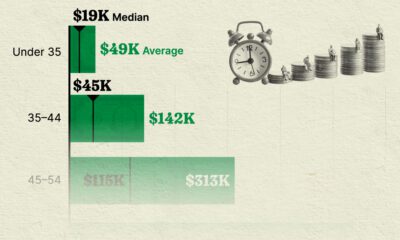
 Money1 week ago
Money1 week agoVisualizing America’s Average Retirement Savings, by Age
-

 Economy2 weeks ago
Economy2 weeks agoVisualizing the Tax Burden of Every U.S. State
-

 Automotive2 weeks ago
Automotive2 weeks agoHow People Get Around in America, Europe, and Asia
-

 Economy2 weeks ago
Economy2 weeks agoMapped: Southeast Asia’s GDP Per Capita, by Country
-

 Demographics2 weeks ago
Demographics2 weeks agoMapped: U.S. Immigrants by Region
-

 Healthcare2 weeks ago
Healthcare2 weeks agoWhich Countries Have the Highest Infant Mortality Rates?
-

 Misc2 weeks ago
Misc2 weeks agoCharted: How Americans Feel About Federal Government Agencies
-

 Mining2 weeks ago
Mining2 weeks agoVisualizing Copper Production by Country in 2023




